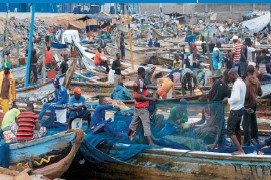 Atlas des pêches et pêcheurs d’Afrique de l’Ouest. États membres de l’UEMOA : Bénin, Burkina Faso, Côte d’Ivoire, Guinée-Bissau, Mali, Niger, Sénégal, Togo. Editeurs scientifiques: Pierre CHAVANCE et Pierre MORAND. Publié en 2020 par IRD Éditions - Institut de Recherche pour le Développement, Marseille, France, et UEMOA - Union Économique et Monétaire Ouest-Africaine, Ouagadougou, Burkina Faso. 163 p. ISBN papier : 978-2-7099-2840-3
Atlas des pêches et pêcheurs d’Afrique de l’Ouest. États membres de l’UEMOA : Bénin, Burkina Faso, Côte d’Ivoire, Guinée-Bissau, Mali, Niger, Sénégal, Togo. Editeurs scientifiques: Pierre CHAVANCE et Pierre MORAND. Publié en 2020 par IRD Éditions - Institut de Recherche pour le Développement, Marseille, France, et UEMOA - Union Économique et Monétaire Ouest-Africaine, Ouagadougou, Burkina Faso. 163 p. ISBN papier : 978-2-7099-2840-3
The book (in French) covers the West African Economic and Monetary Union - WAEMU - member states and is produced within the framework of a vast programme called the "Concerted Fisheries and Aquaculture Development Plan" adopted by WAEMU in 2007. Its main objective is is to improve the quality of statistical data, an essential factor for sustainable management, based on scientific knowledge, for small-scale maritime and inland fisheries.
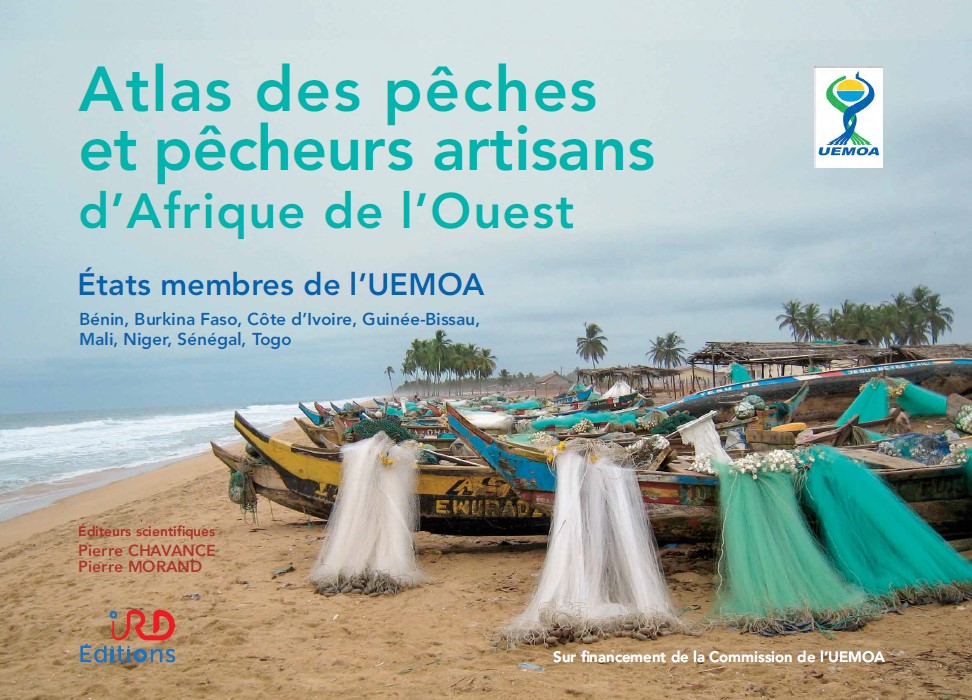 Its realization mobilized a variety of experts: scientific and methodological expertise, computer skills, support from project engineers, national experts in the fisheries sectors in a geographical area with more than 110 million inhabitants, 3,500,126 km2, a diversified coastline, several large rivers (Senegal, Niger) and numerous smaller rivers and a range of water bodies. This atlas is based on many field surveys and has certainly contributed to updating the statistical data, but the unavoidably incomplete coverage of the large number of communities and sectors continues to question their reliability. The first three chapters written by Pierre Chavance and Pierre Morand were essentially devoted to the following aspects:
Its realization mobilized a variety of experts: scientific and methodological expertise, computer skills, support from project engineers, national experts in the fisheries sectors in a geographical area with more than 110 million inhabitants, 3,500,126 km2, a diversified coastline, several large rivers (Senegal, Niger) and numerous smaller rivers and a range of water bodies. This atlas is based on many field surveys and has certainly contributed to updating the statistical data, but the unavoidably incomplete coverage of the large number of communities and sectors continues to question their reliability. The first three chapters written by Pierre Chavance and Pierre Morand were essentially devoted to the following aspects:
-
The characterisation of the populations of fishers and the extent of dependance of certain groups in relation to this economic activity;
-
The contribution of marine and inland water fisheries to food security;
-
The main features of the living conditions and social integration of the populations involved;
-
The food production and economic performance of the two sub-sectors in comparison with the figures for the rest of the world.
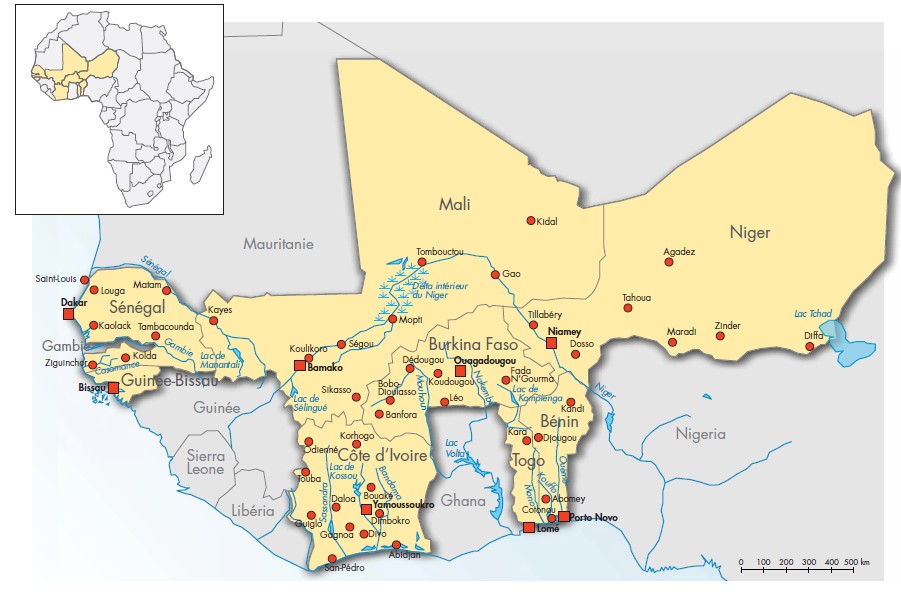
The data collected by the authors' teams were supplemented by those from the fisheries administrations of WAEMU member states. Indeed, eight country sheets were produced by 47 national experts as a contribution to the atlas through a more refined description of the national fisheries situation.
The atlas shows the numerical domination of Beninese and Malians in inland fishing and of Senegalese in marine fishing. Migrants represent 5.5% of the overall workforce in inland fishing and 18.6% in marine fishing, the majority of the latter Ghanaians.
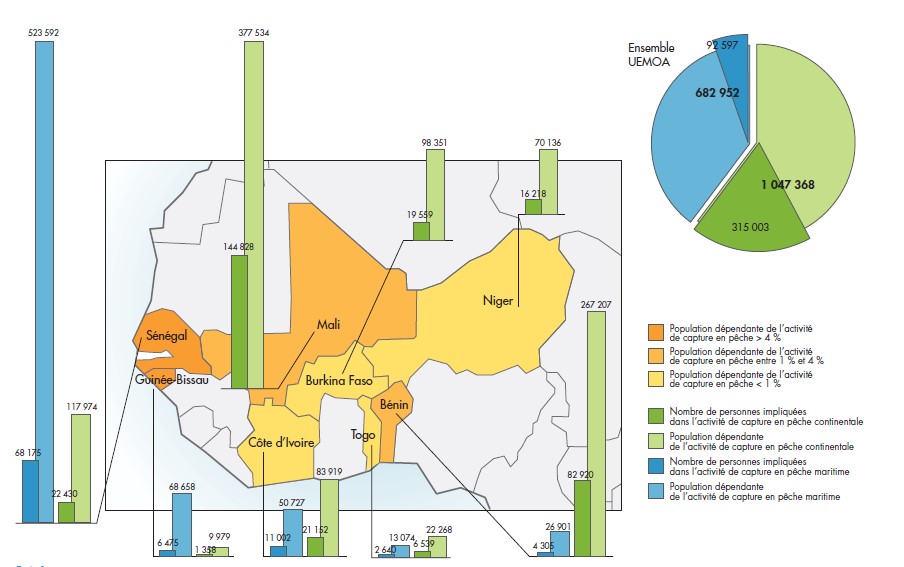
Populations dependent on fishing are estimated at 1,730,320 people, including 1,047,368 people for inland fishing and 682,952 in the maritime domain. Senegal is predominant in marine fisheries with 4.72% of the total population dependent on the activity.
The authors are themselves cautious about these data. According to them, the number of people who depend on fishing is still today underestimated. In addition, they consider that the differences are even greater in artisanal than in industrial fishing. Key players in the value chain were not covered in the frame surveys, particularly in the following sub-activities: processing, fish trading, engin supplies, etc. Dependence on capture or direct extraction activities, which according to the authors seems the best documented, is variable from one country to another. Two countries are at the top: 2.6% in Mali for inland fishing mainland and 3.9% in Senegal for marine fishing.
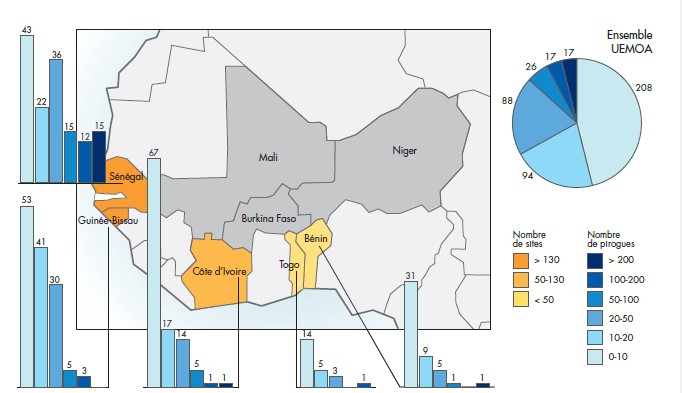
The book confirms that the extraction activity of fish capture remains the domain largely dominated for men: 85.7% are men in inland fishing against 100% for sea fishing. Thus this division of tasks based on gender has not changed at all over time insofar as women still play the biggest role in the postharvest sector, particularly in inland fisheries. The atlas cites 83% of people involved in processing and fish trading are women.
In addition to the specificities in terms of the degree of dependence on fishing and related activities, the authors noted a certain difference in terms of household size on the basis of two criteria: geographical location and age. Indeed, they found that households in the Gulf of Guinea countries are smaller in size. On the other hand, in others, there is a tendency to have more children with the practice of polygamy in the north.
The precariousness of the living conditions of fishing communities and their vulnerability is one of the issues raised in the atlas. These are generally experienced as constrained access to basic services such as: poor housing, access to water, electricity, general collective services and schools. These constraints are identified in both inland and marine fishing villages. However, the authors underline a few variants, namely (i) marine small-scale fishing communities are generally better off in terms of basic services than inland fishing communities: in the access to schools, for example (ii) coastal communities in Senegal are among the best served for some services (relatively speaking).
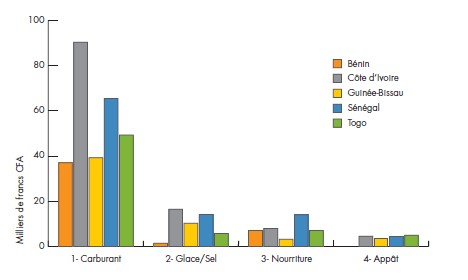 The comparative analysis of the environment of the two types of fisheries reveals a certain number of disparities. For example, less than 10% of inland water canoes are motorised, while this is the case for 78.4% of pirogues deployed at sea. The motorisation differs also by country. For Senegal, it reaches almost 90% in the maritime sector.
The comparative analysis of the environment of the two types of fisheries reveals a certain number of disparities. For example, less than 10% of inland water canoes are motorised, while this is the case for 78.4% of pirogues deployed at sea. The motorisation differs also by country. For Senegal, it reaches almost 90% in the maritime sector.
Some 60% of pirogues use outboard engines of 10 to 20 HP followed by 40-50 HP engines. The study highlighted some disparities insofar as the canoes operating in the countries of the Gulf of Guinea use more standard engines of 25 and 40 HP (classes 20-30 and 40-50) and those on the West African coast prefer 15 CV (class 10-20) engines.
The atlas highlights particularities with regard to the gears used and their degree of importance in the fisheries. The technological choices depend on the resource seasonalities and the deployment of a mix of gears that enables great versatility. This internal dynamic of fisheries is a challenge for a concerted and harmonious management of fisheries.
Gillnets dominate with one out of two units using them, but disparities remain between countries. Its use appears to be significantly higher in Benin, Côte d'Ivoire and Guinea-Bissau compared to other countries. Considering the reported gillnet subtypes bottom set gillnets (FMCF) are the most common in Togo and Benin and drifting gillnets (FMD) in Guinea-Bissau. Encircling gillnets (FME) seem rarer and have only been reported in Côte d'Ivoire and Senegal. About 30% of the marine pirogues use longline and line fishing in its various forms.
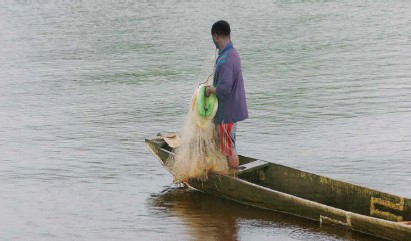 The detailed breakdown by country between hand lines and longlines shows that hand lines are only used in Benin and Togo and longlines in Guinea-Bissau. Côte d'Ivoire and Senegal use both types of gear in a balanced way with a slight prevalence of longlines in Côte d'Ivoire. In third and fourth position we have respectively purse seines (8%) and beach seines (2.3%) which are still in use in Benin, Togo and Côte d'Ivoire. In 20% of cases, versatility is practiced at regional level (mix of gear). In 11% of the cases of multiple gears, set gillnets may be alternated with a drifting gillnet, each deployed in two distinct fishing seasons targeting different species according to their greater or lesser abundance or ease of capture.
The detailed breakdown by country between hand lines and longlines shows that hand lines are only used in Benin and Togo and longlines in Guinea-Bissau. Côte d'Ivoire and Senegal use both types of gear in a balanced way with a slight prevalence of longlines in Côte d'Ivoire. In third and fourth position we have respectively purse seines (8%) and beach seines (2.3%) which are still in use in Benin, Togo and Côte d'Ivoire. In 20% of cases, versatility is practiced at regional level (mix of gear). In 11% of the cases of multiple gears, set gillnets may be alternated with a drifting gillnet, each deployed in two distinct fishing seasons targeting different species according to their greater or lesser abundance or ease of capture.
The authors underline the constraints to a more regular monitoring of the fishing effort particularly with fishing migrations which impacts the quality of the statistical data used. According to them, the reluctance of migrants to accurately answer the questions asked during the surveys poses limits on the appreciation of their real fishing effort in the waters of neighbouring countries. By way of illustration, the authors refer us to their methodological note: "...in Guinea-Bissau, there is only a small proportion (3.9%) of the canoe fleet present which declares to make seasonal migrations, which seems to indicate that the many migrant fishing units from neighboring Senegal were under-surveyed there”.
The caution maintained by the authors as to the reliability of the statistical data used are particularly pertinent for the economic profitability of fishing operations. The ratios between transaction costs and turnover cannot guarantee the profitability of marine fishing trips. Thus, the authors suggest that the only viable strategy should be the diversification of the income sources by fishermen. The alternative that allows the fishers to maintain themselves in capture fisheries may lie in the seasonality of fishing.
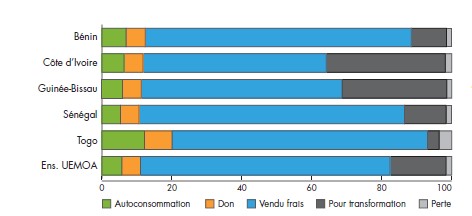 |
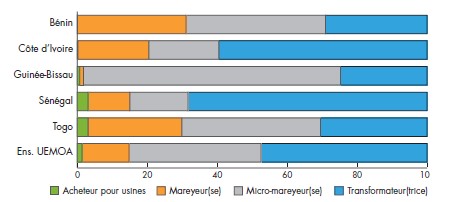 |
| Repartition of marine landings according to estimated use | The relative importanceof different actors in the value chains |
The book focuses on the place of fishery products in food supplies and security. Beween 10 to 20% of total landings, depending on the country, are consumed locally. This being so, the data relating to the number of people involved in fresh fish processing and marketing remain a source of questioning for the authors. They consider it difficult to ensure a realistic count as there is a risk of double counting. Added to this is the mobility of actors, the problem of seasonality and the importance of landings, which can also have an influence. The practices of fish drying and smoking, with variations in the processes, continue to be practiced on a large scale. However, there is a tendency to specialize in this or that technique depending on the country. Senegal is the country tending to offer more diversified products for the processed products market.
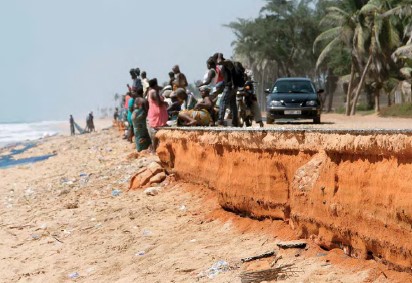 As part of the questionnaire, participants were asked to rate the various shocks and threats facing the fishing communities. In decreasing order of importance, the respondents rated (i) the sea level rise coupled with coastal erosion; ( ii) pollution - the degree of priority depends on whether or not fishing activities coexist with other major pollution generating activities such as the port of Lomé in Togo; (iii) the cutting down of the mangroves. In addition to these factors of environmental degradation, bad weather such as storms that affect the safety of fishermen play an important role.
As part of the questionnaire, participants were asked to rate the various shocks and threats facing the fishing communities. In decreasing order of importance, the respondents rated (i) the sea level rise coupled with coastal erosion; ( ii) pollution - the degree of priority depends on whether or not fishing activities coexist with other major pollution generating activities such as the port of Lomé in Togo; (iii) the cutting down of the mangroves. In addition to these factors of environmental degradation, bad weather such as storms that affect the safety of fishermen play an important role.
The surveys brought to light important innovations introduced by the fishers to improve their safety, including the increasinly widespread use of mobile phones, life jackets, etc. The use of GPS is becoming more frequent mostly in Senegal. Safety equipment is not very widespread in Benin and especially in Togo despite the fact that the swell in the Gulf of Guinea represents a major danger for artisanal boats.
The inland and marine artisanal fisheries sub-sectors operate largely in an informal economy, often dispersed over vast territories in the landlocked countries. The authors explain the great effort of two necessary framework surveys that were carried out for the collection of the data presented in this atlas. They were carried out in 2012 for inland fishing (CP) in the 8 WAEMU countries and in 2014/15 for small-scale marine fishing (PAM) in the 5 coastal countries. To take certain specificities into account, the basic unit in the CP was the household, of which 11,584 were surveyed out of the 68,763 listed in the sites visited and surveyed, ie more than 1,000 per country except Guinea Bissau. The basic units in the MAP were landing sites, of which 515 were listed, and fishing units, 21.5% or almost 4,000 of which were surveyed.
On the one hand, this highlights the difficulty of fisheries departments and national statistical offices, which generally have very meager staff and financial resources, to produce annual statistics on the main indicators. On the other hand, the accelerated changes in recent years in the physical, social, demographic and economic environment call for continuous monitoring, at least by sample, to understand how inland fishing and maritime artisanal fishing are continually changing and adapting. The atlas is therefore a valuable starting tool for a better appreciation of the importance of small-scale fishing, even if the figures have not been updated since. The results of six years of work is made available, among other things, with infographics built on the basis of these surveys. They are available to the public here.
Review by Aliou Sall, October 2022 (IYAFA2022).








